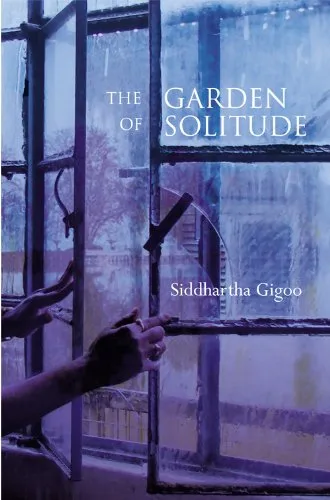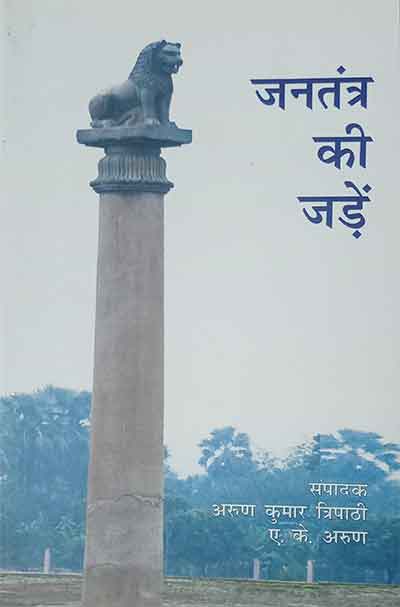The Garden of Solitude is Siddhartha Gigoo’s debut work. Gigoo was born in Downtown, Srinagar in 1974 in a Kashmiri Hindu family. Kashmiri Hindus are generally known as Pandits. For the first fifteen years of his life, Siddhartha Gigoo lived in Srinagar. Then, in 1990, he and his family, alongwith thousands of other families migrated from the valley as a result of the rise of militancy and violence in Kashmir and the concomitant threats to the Pandit identity. At the centre of action in The Garden of Solitude is its protagonist, Sridar. The novel, borne out of authors’ lived experiences, is full of autobiographical details and Sridar represents the life of the author himself. It is also a significant piece of historical fiction which provides many insights into the experience of Kashmiri Pandits vis-a-vis the violence and militancy, and thereby of the modern Kashmiri history and politics. It aims to document this history and experience away from the mainstream historiography.
 The first part of the narrative is set in the 1980s, the decade preceding the era of militancy in Kashmir. It describes Sridar’s peaceful life in his ancestral home in the downtown area of Srinagar. It was a relatively peaceful time in Kashmir when “children had complete freedom to play in the saffron fields and the orchards” and both Hindus and Muslims shared a harmonious social and cultural co-existence, so much so that it was difficult to identify a Muslim from a Hindu as both the communities “abandoned themselves to revelry and celebration” on each other’s festivals. However, things changed dramatically with the rise of militancy in the valley when militants targeted some of the prominent members of the Pandit community. Fearing persecution at the hands of militants as “fear ruled their hearts”, Pandits preferred to migrate to safer places like Jammu and Delhi. Sridar’s family, like other Pandits, was completely shattered by this rapid change of circumstances. Initially, they were torn between migrating and staying on. Eventually, they decided to move to Jammu where temporary refugee camps had been set up for them by the central government. In describing Sridar’s efforts to capture his past, Gigoo condenses dreams as longings for a lost homeland, by recreating memories flitting constantly between past and present reality, and by depicting various forms of dislocation. Fearing that the legacy of his community would be lost forever, Siddhartha Gigoo thinks it essential to document the tragedy of the Pandit community by giving voice to its experiences in The Garden of Solitude.
The first part of the narrative is set in the 1980s, the decade preceding the era of militancy in Kashmir. It describes Sridar’s peaceful life in his ancestral home in the downtown area of Srinagar. It was a relatively peaceful time in Kashmir when “children had complete freedom to play in the saffron fields and the orchards” and both Hindus and Muslims shared a harmonious social and cultural co-existence, so much so that it was difficult to identify a Muslim from a Hindu as both the communities “abandoned themselves to revelry and celebration” on each other’s festivals. However, things changed dramatically with the rise of militancy in the valley when militants targeted some of the prominent members of the Pandit community. Fearing persecution at the hands of militants as “fear ruled their hearts”, Pandits preferred to migrate to safer places like Jammu and Delhi. Sridar’s family, like other Pandits, was completely shattered by this rapid change of circumstances. Initially, they were torn between migrating and staying on. Eventually, they decided to move to Jammu where temporary refugee camps had been set up for them by the central government. In describing Sridar’s efforts to capture his past, Gigoo condenses dreams as longings for a lost homeland, by recreating memories flitting constantly between past and present reality, and by depicting various forms of dislocation. Fearing that the legacy of his community would be lost forever, Siddhartha Gigoo thinks it essential to document the tragedy of the Pandit community by giving voice to its experiences in The Garden of Solitude.
The Pandits in the novel see themselves in vulnerable conditions after militants resort to targeted killings of the prominent members of the community. In these circumstances, Kashmir’s age-old religious tolerance known as Kashmiriyat was plagued by religious hatred as Hindus and Muslims began to view each other as enemies. The bitterness of forced exile amongst Pandits made them view Kashmiri Muslims as the enemy. On the other hand, Pandit migration was perceived by many ordinary Kashmiris as a betrayal of sorts. The contentious issue of Pandit migration gets stuck in these two sharply opposing versions which are indeed difficult to resolve. Gigoo’s response to these versions also finds its place in the novel: “[People] believed what their leaders wanted them to believe. The truth did not matter. The truth did not exist”…Nobody knows the truth. Falsehood has become the truth and people like to listen to things which are not true”.
The Garden of Solitude also has references to the impact of violent insurgency on Kashmiri Muslims but the thrust of the narrative pertains to the Kashmiri Pandits in the form of their exodus and homelessness. It is not that only Pandit perspective has been brought to the fore. To use the term from eminent Russian critic Mikhail Bhaktin, in a “polyphonic” style, Kashmiri Muslim perspective on the Pandit migration has also been given prominence in the novel. In The Garden of Solitude, Gigoo depicts the departure of the Pandits through Manzoor, a Kashmiri Muslim, who tells Lasa (Sridar’s father) “Muslims are safe in Kashmir so long as the Pandits live here.” An old man implores the fleeing Pandits not to migrate as it is not right and that “Islam does not teach violence.” A Kashmiri Muslim friend Ali later writes poignant letters to Sridar’s family in Jammu saying that vested interests have betrayed them all by driving a wedge between Pandits and their Muslim brothers, but the Pandits’ homes and hearts were in Kashmir, and also how an era of violence engulfed Kashmir after the migration of Pandits. But then, there are also many occasions in the novel which reflect the tensions in the relationship between Muslims and Pandits. A young man shouts at the Pandits: “Let the Pandit men leave Kashmir, but let them leave their women behind.” When the militancy begins to get a foothold, leading to the fears of persecution among the Pandits, Lasa tries to allay the fears of fellow Pandits by saying that nothing will happen to Pandits as they have co-existed with Muslims for hundreds of years. Muslims give assurances to Pandit neighbours in unanimous terms: “Do not worry. No one will touch you and your family. This is your home. This land is yours too. You are safe”. None of these assurances from Muslim neighbours and friends, however, has any impact as their fears grow. The Pandits are alarmed with the Muslims’ welcome for gun-toting youth, hailing them as heroes.
Kashmiri Pandits, thus, became cultural as well as spatial migrants in their own land by having to give up the markers of their cultural and geographical identity when moving out of the valley. In their own country, the Pandits were forced to live the life of ‘exile’, ‘exodus’, ‘migrants’ or ‘refugees’, the various descriptions that the Pandits use for themselves. The Pandits felt betrayed by everyone as nobody seemed to care about them any longer.
The exodus from the valley severely impacted the collective consciousness of Kashmiri Pandits. However, their traditions and shared values served to sustain a vital sense of community amongst them. In official documents and records, they were called “Internally Displaced Migrants” and their migration had the potential of obliterating their distinct identity as they were “apprehensive of their identity getting assimilated in a larger Hindu identity”. There was distinctiveness about Kashmiri Pandits and identity which set them apart from their co-religionists in other parts of India. The pathetic living conditions in migrant camps, coupled with the loss of home resulted in the Pandits’, especially their elders being overcome by trauma, depression and dementia. Narrating the trauma of his elderly grandfather, a young Pandit says: “My grandfather barely speaks. He lost his voice while leaving the village… he stopped talking after we crossed the Banihal tunnel. I saw him look sadly at the fading mountains for long, till they disappeared completely, one by one, into his frozen dreams. And he swallowed his fright. Today I cannot hear what he says. His words do not come out of his mouth”.
Despite the years of pain, suffering, homelessness, and the distancing from Muslims, many Pandits nurture hopes of returning back to their homes in the valley. This angst and its reparation is represented in the novel in the words of a Pandit who Sridar meets in the course of collecting individual stories and testimonies for his book. Sridar’s father, Lasa, also nurses this hope when he writes to his old friend, Ali: “This parting is not forever. We will meet. We will re-live the lost time”.
In their 1963 guide to historical fiction, David D. McGarry and Sarah Harriman White come up with a significant proclamation by writing “historical fiction is also an introduction to history”. They go on to elaborate upon the special characteristic of the genre of historical fiction in how it is valuable for the reader in that it not only entertains but also instructs. The point is that by reading historical fiction, we learn things both about the past and present even if they are depicted in fiction. For the inquisitive readers and scholars, this exercise can lead towards more reliable historical sources which will pave the way for more knowledge and scholarship. In its own ways, a historical novel like The Garden of Solitude provides an account to many perspectives that represent the Kashmiri Pandits’ reality and experience consequent to the rise of militancy in the valley. The novel delicately underlines a long-neglected human story which comprises of myriad tales of pain, displacement and suffering. The complex saga of the conflict in Kashmir is sensitively brought out by Gigoo. Nowhere does the narrative lay claim to depicting reality in its entirety or total objectivity; rather, its strength lies in giving voice to multiple dimensions of the conflict. In a major way, this novel offers a deflective narrative trajectory that veers away from the dominant narratives, giving voice to common Kashmiris who have lived through enormous suffering, who have been denied their due place by history, and whose very identity is in danger of extinction.
BASHARAT SHAMEEM, Assistant Professor, Amar Singh College, Srinagar














































